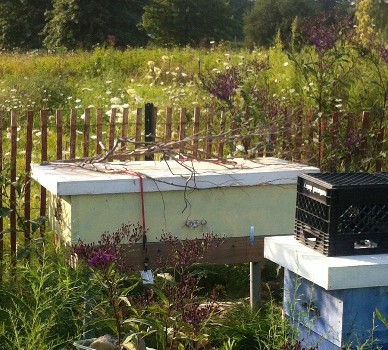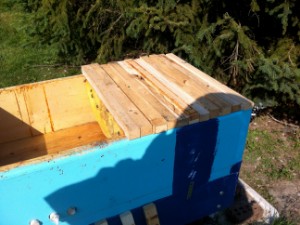
Top Bar Hives in Trish's Backyard
Are top bar hives the same as long hives? Well, much of their management is the same. Adding space so they will draw new comb is the same. Avoiding swarming, and treating, are both just as challenging and have similar solutions. A top bar hive adds difficulty. But I was being cheap! Sometimes, by trying to save a penny, I cost myself a pound. I would not recommend using top bars, or foundationless frames for the brood nest, for new beekeepers. It is fun to use foundationless frames or top bars for summer honey harvesting.

Anatomy of a top bar hive
- Top bar hive parts:
- bars for the comb
- hive body with entrance holes, 3 minimum at about 1 inch across
- screened bottom under the first 10 bars, or a hole in the bottom (at about bar 6-8) for OAV
- lid with white roof paint, and sometimes handles
- base or something to keep the hive off the ground
- 2 bee tight dividers, minimum, per hive
It's that simple! Of course, the devil is in the details....For more on details of the box construction, see my Building a Long Hive page.
How much comb is on that bar? Kenyan vs Straight-sided Top Bar hives
Full disclosure: I have not used a Kenyan top bar hive, and so I have not seen it operate through the seasons in Ohio.
I do know that it is possible for bees to survive the winter just fine in a Kenyan top bar hive.
I also know that the Kenyan top bar hive, at 42", is about 3/4 the volume of 2 deep hives. That space is for the
brood nest AND the honey storage. This is like using a deep and a medium year-round.
The long hives that we made held 25 bars, the width and depth of a deep frame. That's equivalent to 2 deeps and a shallow.
I do not have problems with the comb falling off the bars in my Tanzanian/straight-sided top-bar -
unless I hold the bar sideways, and that is just as much of an issue with Kenyan top bars, or foundationless frames for that matter.
A friend with a Kenyan top bar hive did have issues with comb falling off long after she closed up the hive -
she had a slot about 4" long and less than 1/2" tall as the only entrance, which was so narrow for the bees that
they literally backed up in the air in a traffic jam through the day. So, that's too small of an entrance.
3 holes about 1" across is enough surface area for incoming and outgoing bees, and for bees to ventilate
near the entrance.
Pros and Cons of the Top Bar
Pros of a long hive
- All components of the hive are in one place - no storing and sorting supers and frames elsewhere.
- It can be about 1/3 the price, if you can build your own. We priced the top bar cost out at near $150 for materials, in part because the comb guides are about $1 per bar. The bars are probably about $0.25 without. Frames would be about $2 per, with foundation. That's $50 for 25 frames, but you'd want at least 5 spares. The lid was more expensive than the box! This assumes my husband's time is free...
- Converting from 1 hive to multiple nucs is fast and does not require extra equipment-just place the bee-tight barrier to make up nuc-sized hives, one per entrance.
- Accessing the hive for an inspection is a gentler experience compared to a Langstroth hive.
- Manipulating bars is much more comfortable than grabbing tiny ears of heavy frames. I do miss using bars...
- When the hive is on legs, and the entrance is 3 holes, it's pretty mouse-proof.
- Watching new comb being brought forth is just magical.
- Most important - the heaviest thing you lift is the lid.
Cons of a top bar hive
- Most of these are "cons" for a top bar or foundationless frame.
- Top bar con: Bees will at some point make creative comb over multiple bars, which you then get to "fix".
- Top bar con: Every once in a while, a comb will fall off a bar at some point - then you get to "fix" things here too.
- Top bar con: Bees will attach the sides of new comb to the walls, requiring bee-intrusive comb cutting on the sides to free the comb, with every inspection during a nectar flow.
- Top bar con: Because the bees can attach comb to the sides at almost any time during the flying season, each bar needs to be separately moved - so it takes much longer to inspect a hive, or to get to a target bar.
- Top bar con: Once the queen has enough brood space, new comb is drawn with large cells suitable only for drone comb or honey, never for more worker-sized comb. This makes it harder to boost a hive with resources.
- It is harder to treat for mites.
- It is harder to add space, and thus prevent swarming.
- It is harder to keep the queen from laying in your honey bars (for drones).
- If you make new space for honey comb to be drawn out each year: You will miss out on honey from a shallow nectar flow - the bees consume or store nectar from a shallow flow, rather than drawing comb and then storing honey.
- If you don't make new space for honey comb to be drawn out each year: you will have swarming every year, unless you pull the queen.

Common Myths about Top Bars/Long Hives
- Top bars: It's not more natural. The bees naturally want to make messy comb and have smallish brood nests, and we prevent both of those things in a top bar hive.
- Top bars: It's not a mite-reduction strategy to allow more natural comb. Top bar hives are just as good at dying of mites as Langstroth hives.
- They handle cold and winter with no problems, provided they have enough winter bees (6 bars is fine), enough honey (6 honey bars in addition to the 6 covered is fine), and the mite load is not high.
- It's not too costly for the bees to use nectar for wax for each bar of honey (rather than just filling pre-drawn comb) - it is about 0.3 lb of wax for one deep frame, which is 3 lbs of wax for 80 lbs of honey in 10 deep frames. If it takes 8 lbs of honey to make 1 lb of wax, then 24 lbs of honey were spent on storage. If the bees store 8 lbs of honey in each deep frame, then they had to gather 3 frames + 10 more frames of honey to draw out AND fill 10 deep frames. Would you miss 3 deep frames of honey, if you had 1 lb of wax to play with?
I miss my top bars... but I wanted a larger apiary
I have to confess, I moved away from top bar hives because they take so dang long to inspect. You can start from the brood end,
or from the honey end, but either way you have to spend about 1 min to carefully move each bar. It is much faster to get to
any given frame in a tower hive system. It is more pleasant to inspect a long hive though...
And because swarm prevention and mite treatment are harder in a top bar hive, I do not recommend starting with one for new beekeepers.
If someone truly needs to start with a top bar hive as their first hive, be aware that:
- mite treatment options are limited to Apivar strips, and oxalic acid based treatments;
- feeding sugar syrup is more challenging in a top bar hive;
- preventing swarming is very challenging without removing the queen in late spring;
- harvesting honey is more challenging.
But it can be done! Where there is a will, there is a way. Just don't be afraid to change the box you're using for the bees, if you find it doesn't suit your needs.